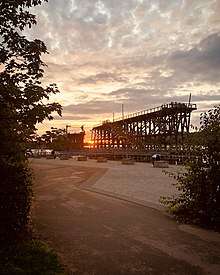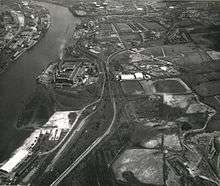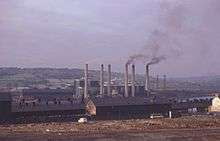Dunston, Tyne and Wear
Dunston is a village in the western area of the town of Gateshead on the south bank of the River Tyne, in the Metropolitan Borough of Gateshead, North East England (into which it was absorbed in 1974). Dunston had a population of 18,326 at the 2011 Census.

History
It has been speculated that Dunston started its existence as a farm or estate of a man named Dunn.[1] Historically part of County Durham, Dunston was first mentioned in 1328. Salmon fishing and farming were important industries in Dunston from at least the 14th century. Coal mining on a small-scale was also important but by the 17th century, the proximity of the river aided the development of large-scale coal mining in the village. During the Great Tyne Flood of 1771, villagers had to be rescued by boat from the roofs and upper stories of their houses.[2]
Area
Dunston is served by Dunston railway station on the Tyne Valley Line.[3]
Dunston is split into two areas separated by the A1 dual carriageway. Much of the area south of the A1 is known as Dunston Hill. For electoral purposes, the northern section is grouped along with the Teams area to form Dunston and Teams ward, while the southern section is combined with parts of Whickham, forming Dunston Hill and Whickham East.
To the west of Dunston is the site of Dunston Power Station, now demolished. The site is now home to Costco, with the MetroCentre (at this time the largest shopping and leisure complex in Europe), occupying the former site of the station's ash ponds.[4] The Gateshead-based Go-Ahead Group has constructed a new bus depot to replace its Sunderland Road and Winlaton depots on the eastern part of the power station site. Another Dunston landmark was the Derwent Tower (commonly known as the "Dunston Rocket"), a tower block that was once the highest building in Gateshead. It was designed by the Owen Luder Partnership and completed in 1973.[5] A well-known structure that had appeared in two films, it was demolished in 2012. It had always proved unpopular with residents, and fallen into a poor condition: Gateshead Council decided that the renovation costs would be prohibitive.[6] As of 2016, the remainder of the late 1960s Tower Court development was being gradually replaced by new housing and shops. Luder also designed the similarly maligned Trinity Centre Multi-Storey Car Park, (known for its appearance in the 1971 gangster thriller Get Carter, and now demolished), in Gateshead town centre.
On 6 June 1993 the IRA attacked a gas holder in the nearby area of Low Team. The damage was limited, and no one was injured.[7]
Sports
Dunston has one sports team which is association football club called Dunston UTS who currently play in the Northern Premier League Division One North West.
Dunston Staiths and the 1990 Garden Festival
Dunston is particularly known for wooden coal staiths, first opened in 1893 as a structure for loading coal from the North Durham coalfield onto ships.[8] In the 1920s, 140,000 tons of coal per week were loaded from the staiths, and they continued to be used until the 1970s. They were also a shipping point for coke produced at the nearby Norwood Coke Works, as well as pencil pitch manufactured at the Thomas Ness Tar Works using by-products from the Norwood plant and the Redheugh Gasworks. Throughout their working life, motive power for shunting wagons on the staiths and in their extensive sidings known as the Norwood Coal Yard came in the form of locomotives from Gateshead MPD. The staiths' output gradually declined with the contraction of the coal industry, and they were finally closed and partially dismantled in 1980. Now redundant, the railway lines leading to the staiths were lifted, finally allowing the demolition of several low bridges that had become a nuisance to bus operators by limiting the routes available to double-deckers in the area. For many years, the men who worked on the staiths, known as teemers (the men who released the coal from the wagons and operated the loading chutes and conveyors) and trimmers (who had the dangerous job of ensuring the stability of the colliers by levelling the load in their holds as they were filled), had their own room in the nearby Dunston Excelsior Club. For anyone not employed in the club or on the staiths, access to the room was strictly by invite only, and the staithesmen held a reputation for unceremoniously ejecting anyone who fell foul of this rule.

The staiths was restored and opened to the public as part of the Gateshead Garden Festival in 1990, following similar events in Liverpool (1984), Stoke-on-Trent (1986) and Glasgow (1988).[9] The Garden Festival was divided into five zones, Norwood, Eslington, The Boulevard, Dunston and Riverside. It was spread over a large area of Dunston and the lower Team Valley, formerly occupied by heavy industries. Though other parts of the Garden Festival site, such as Dunston, (the site of the Norwood Coal Yard), Eslington, (the site of the tar works), and Norwood, (the site of the coke ovens) in the Team Valley, gained an immediate spur for regeneration, The Boulevard was left as a green space. Riverside, which was centred around the staiths and the site of the former gasworks, was derelict and inaccessible for the remainder of the 1990s, although parts of the site have now been developed into new housing.

The staiths are reputed to be the largest wooden structure in Europe,[10] and are protected as a Listed Building and a Scheduled Ancient Monument. In 2002, work began on a development of riverside apartments and houses designed by Wayne Hemingway. Known as Staiths South Bank, this development celebrates the area's heritage as well as improving the setting for the historic structure. In the early hours of 20 November 2003, a section of the staiths was destroyed by fire.[11] As a result, access onto the Staiths themselves is not possible, but the structure can be viewed from the new riverside walkway, constructed as part of the Staiths South Bank development. In 2005 Gateshead Council commissioned a study into possible options for the Staiths' restoration. The Staiths suffered further fire damage in July 2010.[12] Following the award of a Heritage Lottery Fund grant of almost £420,000, restoration of the structure is expected to begin in the near future.[13] It suffered further fire damage on 16 May 2020. [14]
Notable people
Footballers Paul Gascoigne[15] and Ray Hudson,[16] and the former lead singer of AC/DC Brian Johnson[17] all spent their formative years in Dunston. Champion rower and boat-builder Harry Clasper[18] was born in Dunston, and Victoria Hopper, the celebrated Canadian-born British stage and film actress and singer, was raised in Dunston. British cyclo-cross and road cyclist Thomas Mein was also born in Dunston.[19]
References
- https://englandsnortheast.co.uk/team-valley/
- http://www.gateshead-history.com/dunston.html
- "More trains call at Dunston and Blaydon". Nexus.
- V5. "intu Metrocentre, Tyne and Wear Shopping Centre". V5.
- SINE Project: Derwent Tower Archived 20 March 2008 at the Wayback Machine
- "Tyneside Dunston Rocket demolition begins". BBC News.
- "Damages bid over bombing arrests". The Northern Echo. 20 January 2003. Archived from the original on 8 October 2007. Retrieved 29 July 2007.
- "Dunston Staiths".
- Henderson, Tony (13 May 2015). "Gateshead National Garden Festival: 25 years since the event on Tyneside". nechronicle.
- Sitelines archaeology project: Dunston Staiths Archived 6 November 2005 at the Wayback Machine
- "BBC NEWS – UK – England – Tyne/Wear – Coal heritage goes up in flames".
- nechronicle Administrator (7 July 2010). "Firefighters tackle blaze at Dunston Staithes". nechronicle.
- "Gateshead's Dunston Staithes could be opened to public". BBC News.
- "Dunston Staiths fire: Historic timber landmark in Tyneside devastated by blaze after suspected arson attack". The Independent.
- English-Football.org.uk: Paul Gascoigne Archived 25 June 2006 at the Wayback Machine
- Ray Hudson
- "AC/DC rock star Brian Johnson tells all in autobiography". North East Life.
- Harry Clasper
- "Thomas Mein", Wikipedia, 3 March 2020, retrieved 4 March 2020